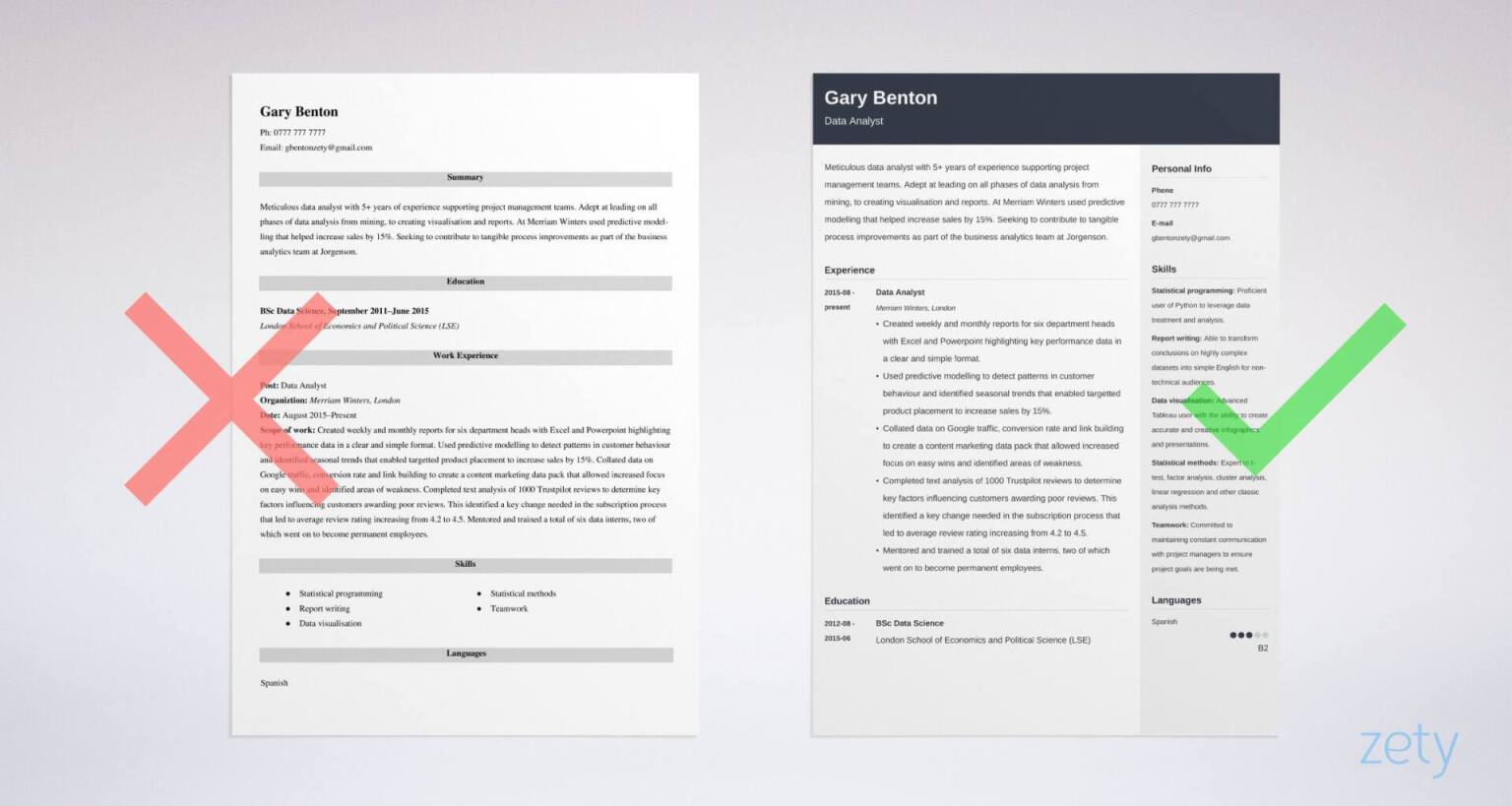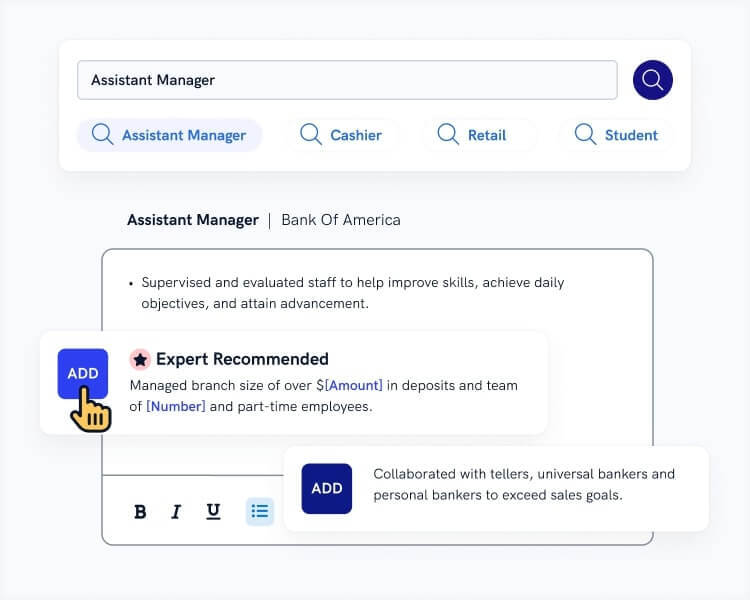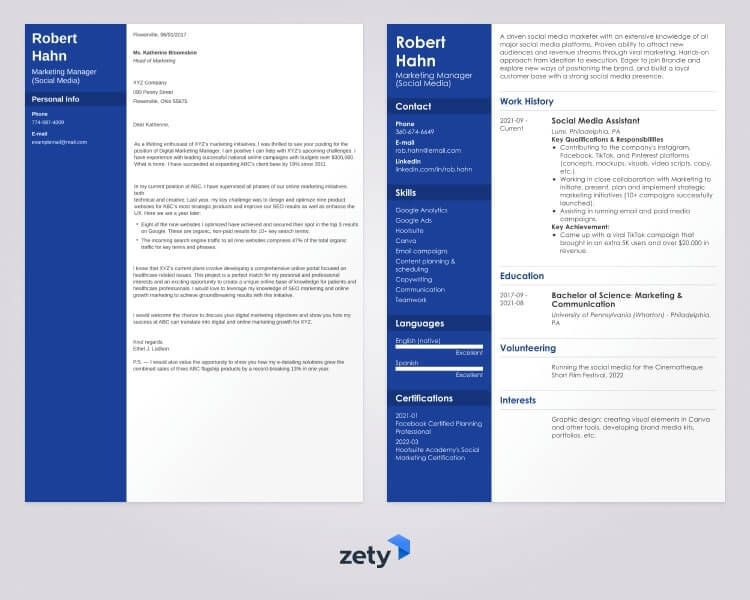Data Analyst CV Example & Guide for 2026
Create your CV nowTo get hired as a data analyst, you must prove to the companies that you can transform numbers into easily understandable advice. The best way to do that is with a well-written data analyst CV.
Read on to discover a data analyst CV template that you can use as the basis for your own. You’ll also get simple step-by-step instructions to write a CV for data analyst jobs that’ll get you interviewed by the best employers.
This guide will show you:
- A data analyst CV example better than 9 out of 10 other CVs.
- How to write a data analyst CV that will land you more interviews.
- Tips and examples of how to put skills and achievements on a data analyst CV.
- How to describe your experience on a CV for data analyst jobs.
Want to save time and have your CV ready in 5 minutes? Try our CV builder. It’s fast and easy to use. Plus, you’ll get ready-made content to add with one click. See 20+ CV templates and create your CV here.
Data analyst CV made with our builder—See more CV examples here.
And if you’re looking for advice for other careers, you can analyse these:
- Business Analyst CV Example
- Warehouse Operative CV Example
- Customer Service CV Example
- Pharmacist CV Example
- Engineering CV Example
- Web Developer CV Example
- Marketing CV Example
- Model CV Example
- Architecture CV Example
- CV Examples for All Jobs
Data analyst CV example
Gary Benton
Data Analyst
0777 777 7777
gbentonzety@email.com
Summary
Meticulous data analyst with 10+ years of experience supporting project management teams. Adept at leading all phases of data analysis from mining to creating visualisations and reports. At Merriam Winters, used predictive modelling that helped increase sales by 15%. Seeking to contribute to tangible process improvements as part of the business analytics team at Jorgenson.
Work Experience
Data Analyst
Merriam Winters, London
August 2015–October 2025
- Created weekly and monthly reports for six department heads with Excel and PowerPoint, highlighting key performance data in a clear and simple format.
- Used predictive modelling to detect patterns in customer behaviour and identified seasonal trends that enabled targeted product placement to increase sales by 15%.
- Collated data on Google traffic, conversion rate and link building to create a content marketing data pack that allowed increased focus on easy wins and identified areas of weakness.
- Completed text analysis of 1000 Trustpilot reviews to determine key factors influencing customers awarding poor reviews. This identified a key change needed in the subscription process that led to the average review rating increasing from 4.2 to 4.5.
- Mentored and trained a total of six data interns, two of whom went on to become permanent employees.
Education
BSc Data Science, September 2011–June 2015
London School of Economics and Political Science (LSE)
Skills
- Statistical programming: Proficient user of Python to leverage data treatment and analysis.
- Report writing: Able to transform conclusions on highly complex datasets into simple English for non-technical audiences.
- Data visualisation: Advanced Tableau user with the ability to create accurate and creative infographics and presentations.
- Statistical methods: Expert in t-test, factor analysis, cluster analysis, linear regression and other classic analysis methods.
- Teamwork: Committed to maintaining constant communication with project managers to ensure project goals are being met.
Languages
- Spanish—B2
And here’s the formula for writing your own data analyst CV.
1. Choose the best format for your data analyst CV
A data analyst examines sets of raw data using analytical tools. They then use that data to draw inferences and produce meaningful and easily understandable results to help businesses make decisions.
The purpose of your data analyst CV is to demonstrate your ability to understand complex sets of numbers and translate them into clear, concise English to inform strategy and decision-making. By the same token, your CV has to take the complex dataset of your work history and skills and transform it into a simple document to help drive the recruiter’s decision to hire you. Here’s how to do it.
- Choose the best CV format. For a data analyst CV, that format is called chronological. It’s the basic and easy-to-read format that hiring managers know best.
- Set up a well-laid-out CV structure. Your page margins need to be one inch on all sides, you should double-space between CV sections and use left-alignment only. Doing this creates white space, an important design trick that makes your CV easy to read.
- Select an easily readable CV font. There’s endless debate over which ones are best, but we recommend you stick to the basics. Times New Roman, Arial and Calibri are all perfect choices.
- Never include unnecessary personal details such as your marital status, date of birth or photograph.
- And when you’re finished writing, save it as a PDF to keep the layout in mint condition.
Read more: How to Layout a Professional CV
2. Write a data analysis CV personal profile
When you present your work, you probably kick off with a brief summary of your findings. And that’s what your CV personal profile does. It’s the introduction to the content that follows. Also known as a personal statement or CV summary, it should be 3–4 lines long and effectively grab the hiring manager’s attention.
The best way to write it is to think of it as a way of answering these questions.
- Who are you?
- What can you offer to the employer?
- What are your career goals?
And that approach works for all levels of experience. You simply adjust your answers accordingly. So, for experienced candidates writing a senior data analyst CV, use this method.
- Write up a list of your experience and abilities as a data analyst. Consider the full picture of everything that makes you good at your job.
- Read the job advertisement and highlight all the skills and experience required.
- Then choose 3–4 points from your own list that match up with what the job requires to write a targeted personal statement.
For candidates without extensive experience and writing a junior data analyst CV, please follow this approach.
- Make a list of all the knowledge and experience you’ve gained through your education and other jobs, if you’ve had them. Then highlight everything that’s transferable to a data analyst role.
- Then you write your personal statement by combining a few of your transferable skills with enthusiasm for the role and for the company you’re targeting. Showing some positive energy helps prove you’ll be a productive and committed new team member.
And for both junior and senior data analysts, you should save this section until last. After all, it’s a CV summary, and that’s easier to do if the main body of your content is written and ready to refer to.
Read more: How to Write an Effective CV Summary
3. Create a convincing data analyst CV work experience section
Your CV needs to prove you can jump right in and get knee-deep in data. And the best way to show that is with a well-written work experience section. Here’s how to deliver.
- List your work history in reverse chronological order, with your most recent job going first.
- Include the essential details about each post. Your job title, the name of the company, your location of work and your dates of employment
- Write up to six bullet points per job that describe your role. But don’t just list your duties. Give each bullet point added energy by starting it with a CV action verb. Think adapted, calculated, or analysed rather than ‘responsible for’.
- Quantify your achievements with numbers and use the accomplishment statement method to add even more impact.
- And make sure you’ve created a tailored work experience section. Refer back to the job advert and ensure you’ve addressed the key requirements as closely as possible.
Read more: How to Write a Convincing CV Work Experience Section
4. Include an education section in your data analyst CV
When you’ve just graduated, your education feels like the main defining factor in your CV. Once you’ve been working for a few years, though, it can feel like a distant memory. However, regardless of your career stage, you need an education section in your data analyst CV, and it must follow the same basic format. Here’s how to do it.
- Write the name of the university you attended, the degree you graduated with, and your dates of study. Enter your expected graduation date as the end date if you’re still studying.
- If you hold postgraduate qualifications, list your degrees in reverse chronological order.
- Only list 1st class or 2:1 honours, and if you’ve just graduated within the last 12 months and have limited work experience, you can put this section first before your work history.
- Another change new grads can make is to include the details of relevant particular modules they studied. It’ll help show your knowledge in the absence of practical experience.
Read more: How to Write Your CV Education Section
5. Demonstrate your data analyst CV skills
Being a successful data analyst requires a wide variety of skills. It isn’t just about the ability to literally analyse data; you need to be able to communicate effectively with colleagues who don’t have the same level of technical knowledge. It’s an incredibly broad skill set, so how do you choose which ones to include in your CV? After all, space is limited, so aim for a one- or two-page CV.
Here’s how to create a concise and effective list of skills.
- Dust off the job advert again and note all the skills mentioned. Then write a second list consisting of your own skills. Use your work experience and education sections as a prompt.
- Then see what matches on the two lists and choose 5–10 skills to include on your CV. Ensure it’s a mix of both soft skills and hard skills.
- And for each skill, include a short sentence that helps to demonstrate your proficiency. It’s much more effective than simply listing skills. E.g. Statistical programming: Proficient user of Python to leverage data treatment and analysis.
Here are some skills that would look great on a CV for data analyst jobs.
Essential Data Analyst Skills
- Report writing
- Data mining
- Data visualisation
- Database design
- Statistical methods
- Attention to detail
- Teamwork
- Communication skills
- Problem-solving
- Statistical script and programming languages
Read More: Best Skills List For Your CV [Popular Skills & Examples]
When making a CV in our builder, drag & drop bullet points, skills, and auto-fill the boring stuff. Spell check? Check. Start building your CV here.
When you’re done, Zety’s CV builder will score your CV and tell you exactly how to make it better.
6. Put additional sections in your data analyst CV
You can’t make accurate decisions with incomplete data, and it’s the same when you’re writing a data analyst CV. Without a complete picture, the hiring manager can’t make an accurate decision, i.e. inviting you for an interview. The best way to fill in the gaps and complete the recruitment dataset is to add extra sections to your CV. Here are some examples.
- Add a languages section if you can speak a foreign language. Evidence shows that linguistic skills increase your chances of getting a better job.
- Other ideas include volunteering, awards, hobbies and interests. Anything relevant that will help the hiring manager see you as a high-quality candidate is worth including.
Read more: Best List of Hobbies and Interests for Your CV
7. Add a cover letter to your CV for a data analyst
To get the best jobs, you need to submit the best application possible. And the best way to take your job application to the next level is with a convincing cover letter. Here’s what to include in a cover letter for a data analyst role.
- Select the correct cover letter format and ensure that you address your cover letter according to UK business letter requirements.
- Use your cover letter opening as a hook to get the recruiter’s attention. Show off a professional accomplishment that’ll make them hungry for more.
- Strengthen your cover letter structure in the middle paragraphs by adding in even more proof of your abilities, and show enthusiasm for the role and the company.
- Add a call to action to your cover letter ending to increase your chances of an interview. All you need to do is ask the hiring manager to contact you so you can discuss the role further. Good things come to those who ask.
- Know when to stop. The ideal cover letter length is one page or less.
- And choose a matching CV and cover letter template for an extra-professional touch.
If you want to give your application one final push, follow up on it. If you’ve not had any news within a week of applying, then get in touch with the employer to check up on the status of your application.
Plus, a great cover letter that matches your CV will give you an advantage over other candidates. You can write it in our cover letter builder here. Here's what it may look like:
See more cover letter templates and start writing.
About Zety’s Editorial Process
Our editorial team has thoroughly reviewed this article to ensure it follows Zety’s editorial guidelines. Our dedication lies in sharing our expertise and providing you with actionable career advice that offers you real value. Every year, the quality of our content attracts 40 million readers to our site. But that’s not all – we conduct original research to gain a detailed understanding of the labour market. We take pride in being cited by top universities and leading media outlets in the UK and worldwide.






